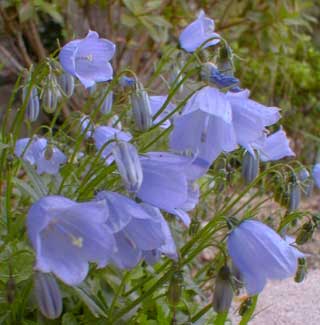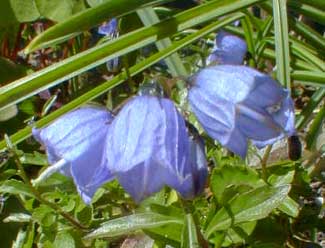
'Bavarian Blue' Fairy Thimbles;
aka: Spiral Bellflower, or
Dwarf Earleaf Bellflower
"Skimble where is Skimble
has he gone to hunt the thimble?
We must find him or the train can't start."
"Skimbleshanks the Railway Cat"
by T. S. Elliot
(1888-1965)
by T. S. Elliot
(1888-1965)
Campanula chochleariifolia should have its species-name spelled with the double "i" but is frequently spelled with one. It was formerly called C. pusilla & still sometimes listed as such.
For us, the tiny pale 'Bavarian Blue' Fairy Thimbles show themselves from April to September, though in chillier zones they will not begin until June. The first photo shows them in April several times life size.
The first photo shows them in late June much more numerous over the foliage, still larger than life size, as these are much the smallest bellflowers of any campanula we have.
A European alpine flower common in the Pyranees, it is extremely cold hardy. It seems to prefer morning sun & not too much afternoon sun in order to flower to its fullest, & will also do well in bright shade or dappled sunlight, but will rapidly decline in deeper shade.
The foliage forms a spreading mat one to three inches tall. The species name means "spoon-shaped leaves" & the leaves are quite tiny, round to slightly ovate, & serrated.
 The leaves & flowers are edible with a mild pleasant flavor, whether sprinkled over salads to be eaten raw, or cooked with other greens.
The leaves & flowers are edible with a mild pleasant flavor, whether sprinkled over salads to be eaten raw, or cooked with other greens.It will travel into any unused ground by means of stolons, but is too small to displace anything larger than itself, hence a truly splendid "filler" between larger perennial clumps. If it does spread into areas where it isn't wanted, it is easily removed.
Being so very tiny it can share ground with crocuses or miniature daffodils so that when the early or pre-spring bulbs are finished, the area will still have some leafiness & color, but never so large as to hide or obscure the smaller bulbs.
I planted Fairy Thimbles over a dwarf iris, & if occasionally the foliage were to hump up higher than required for the sake of the earliest spring bulbs, it can be sheered even closer to the ground without afflicting its flowerful performance in summer. As a die-back perennial, generally it is only just getting re-started when the early bulbs are at their peak, so there is no conflict.
They like moist very well drained soil, either light or humusy. It will creep over garden ledges into sunlight, forming small cascades. It does well in containers as well as rockeries, but by its smallness is easily overwhelmed even by other groundcovers. In the mountains where it grows wild it often seeds into rocky ledges with so little soil very little else bothers to compete with it, & Fairy Thimbles can started right in the cracks of garden walls.
C. punctata 'Cherry Bells'